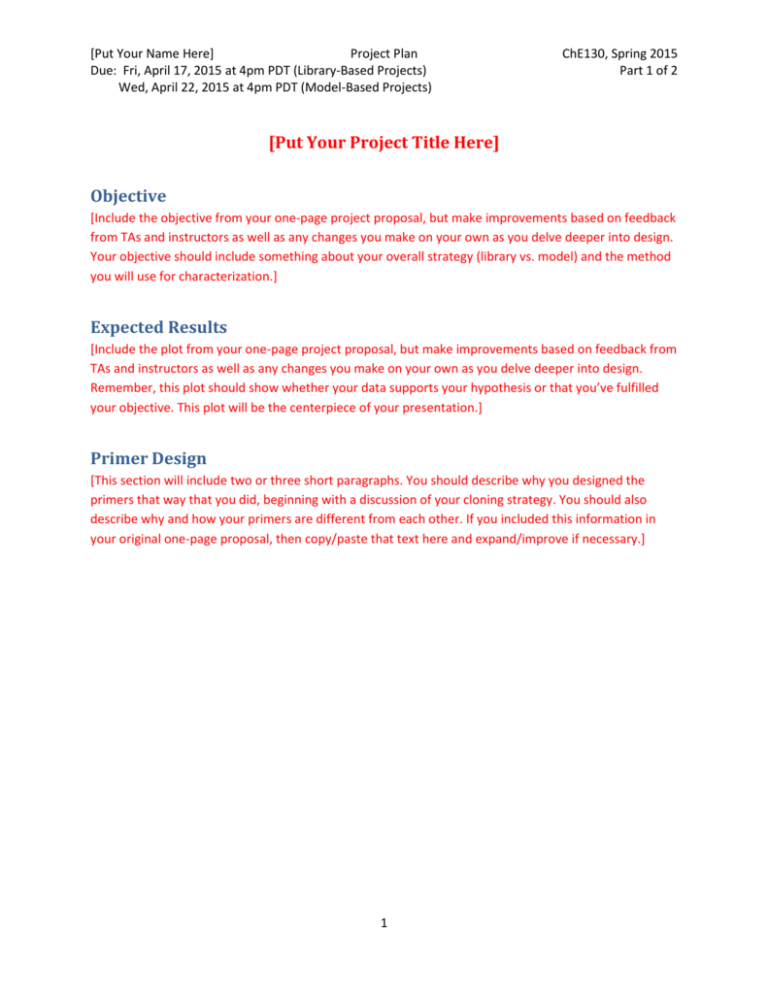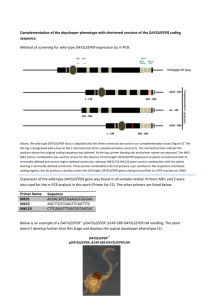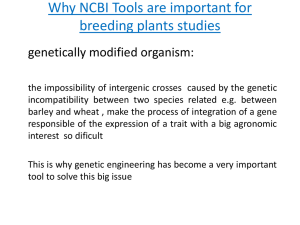Template for Plan, Part 1
advertisement

[Put Your Name Here] Project Plan Due: Fri, April 17, 2015 at 4pm PDT (Library-Based Projects) Wed, April 22, 2015 at 4pm PDT (Model-Based Projects) ChE130, Spring 2015 Part 1 of 2 [Put Your Project Title Here] Objective [Include the objective from your one-page project proposal, but make improvements based on feedback from TAs and instructors as well as any changes you make on your own as you delve deeper into design. Your objective should include something about your overall strategy (library vs. model) and the method you will use for characterization.] Expected Results [Include the plot from your one-page project proposal, but make improvements based on feedback from TAs and instructors as well as any changes you make on your own as you delve deeper into design. Remember, this plot should show whether your data supports your hypothesis or that you’ve fulfilled your objective. This plot will be the centerpiece of your presentation.] Primer Design [This section will include two or three short paragraphs. You should describe why you designed the primers that way that you did, beginning with a discussion of your cloning strategy. You should also describe why and how your primers are different from each other. If you included this information in your original one-page proposal, then copy/paste that text here and expand/improve if necessary.] 1 [Put Your Name Here] Project Plan Due: Fri, April 17, 2015 at 4pm PDT (Library-Based Projects) Wed, April 22, 2015 at 4pm PDT (Model-Based Projects) ChE130, Spring 2015 Part 1 of 2 Materials: Primers In this section, I calculated all primer properties, such as melting temperature and GC content. Primer names follow this form: FML_DIR_DESCRIPTION All characters are upper case letters and numbers. No Greek characters. F = First letter of your first name. M = First letter of your middle name. If you have no middle name, use N. L = First letter of your last name. (If you have two initials in your last name, use them for ML.) DIR = FWD for forward primer; DIR = REV for reverse primer. DESCRIPTION = fewer than 18 characters to describe function, composition or design difference. A few notes about using the DECRIPTION portion of the primer name Include three letters to indicate whether you’re working on the promoter (PRM) or RBS region Use a name that can be identified with the intended sequence. When you ask TAs for help, it’s easier when you have primer names that are easy to identify. Remember you’re working on one project, but the TAs and instructors are tracking more than 20 projects. For instance: o Instead of using RBS1 and RBS3, try RBS_AGANNN and RBS_NNNNNN. o You don’t need to include the sequence if it’s too long, but you should identify a key feature, such as PRM_SPCR_DEL22, which specifies the desired construct has a deletion at position -22 in the spacer region of the promoter. A few things to check before you send us primers. These are mistakes commonly made by students in the past. Did you exceed the number of constructs you’re allowed to have? Is there a binding region? Did you put it on the proper side of the primer? Did you accidentally switch your forward and reverse primers? (Check again.) Does your primer have fewer than 60nt (working in/near RBS or -35 box) or 70nt (working in/near-10 box)? On the following tables, did you: o Leave spaces between sets of three nucleotides? o Start with the 5’ end on the left side? o Underline the binding region? o Identify components in the overhang region? o Use ‘N’ to represent a random nucleotide? (Library-based projects only) [Delete the red text, then copy and paste the table multiple times so each primer has its own table.] 2 [Put Your Name Here] Project Plan Due: Fri, April 17, 2015 at 4pm PDT (Library-Based Projects) Wed, April 22, 2015 at 4pm PDT (Model-Based Projects) Primer Name: Sequence: (start with 5’; underline binding region) ChE130, Spring 2015 Part 1 of 2 MAV_FWD_AGGAGG_SPACER2BP 5’- GCA ATT GAG CTC GGC CAC AGG AGG ACA TGC AGT TTA AGG TTT ACA CC- 3’ Overhang 1-26 Binding Region 27-47 Identify Primer Regions: GCA ATT [SacI cut site] GGC CAC [RBS] [Spacer] SacI cut site = GAG CTC (same for all forward primers) RBS = AGGAGG (varies) Spacer = AC (varies) Plasmid: pZE_Plac-YPET Plasmid Region (bases): 43 – 63 Primer Purpose: (brief explanation) Length (# of bases), Entire Primer: Length (# of bases), Binding Region: GC Content (%): Melting Temperature (C), Entire Primer: Melting Temperature (C), Binding Region: Length Difference (# of bases) Between Primer Pairs: Melting Temperature Difference, |T|, Between Primer Pairs (C): GC Clamp on 3’-end? Typical: varies based on overhang (Max: ~60nt OR 70nt) Typical: 18-25 bases Typical: 40-60% Typical: 50-60C Typical: <3 bases Typical: <5C but <2C is better Typical: Yes. 3’ base is G or C References [In this section, you should include any and all references to which you referred in the text. Don’t include a source if you didn’t refer to it in the text.] 3 [Put Your Name Here] Project Plan Due: Fri, April 17, 2015 at 4pm PDT (Library-Based Projects) Wed, April 22, 2015 at 4pm PDT (Model-Based Projects) ChE130, Spring 2015 Part 1 of 2 Construction Timeline [In this section, you should provide a timeline for the construction phase of the project. If your primers pass through our quality control process, one of the TAs will order them the day after you submit this proposal; you should receive the primers approximately 2-3 days later. If the TA finds issues with your primers, you will receive feedback and be asked to resubmit them. WHEN YOU PLAN YOUR PROJECT, REMEMBER THE WE HAVE LIMITED LAB HOURS: YOUR LAB TIMES ARE MON/TUE/THU/FRI 1-4PM AND SUN/MON/WED/THU/FRI 11PM-1AM. (LATE NIGHT HOURS WILL BEGIN SUNDAY, APRIL 19.) ALSO, WEEKS 4, 5 AND 6 ARE SET ASIDE FOR CONSTRUCTION, SO YOU SHOULD PLAN TO FINISH ALL TASKS ASSOCIATED WITH CLONING BEFORE FRIDAY OF WEEK 6 (MAY 8). Finally, you should refer to the Tutorial Timeline on the course website to remind yourself how long you have to wait between steps, because the head TA performed most of these tasks for you.] DATE TASKS ESTIMATED TIME IN LAB (HOURS) 4





